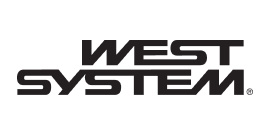Volatile Emissions
Clean air regulations have added new requirements to reduce emissions of volatile organic compounds (VOCs) and other air pollutants.
Because of these regulations and other environmental concerns, many customers are asking builders to use products that pollute less. The volatile emissions from our epoxies are much lower than that of conventional vinyl esters and polyesters used in the composites industry. While our epoxy doesn’t have one major or easily identifiable volatile component, emissions may include small amounts of benzyl alcohol, low-molecular-weight amines, or a reactive diluent.
To put it into perspective, making a laminate that requires 10 gallons of conventional vinyl ester resin would put 30 pounds of VOCs into the air. A laminate requiring the same quantity of WEST SYSTEM® Epoxy would emit only one pound of VOCs. Consider the environmental impact when choosing the products you will use on your projects.
Disposal of Leftover Resin and Hardener
WEST SYSTEM Epoxy Resin and Hardeners are not considered hazardous wastes in their purchased form, using the criteria outlined in the Resource Conservation and Recovery Act (RCRA). Some state and local regulations, and disposal facilities may require additional lab analysis or evaluation of a Material Safety Data Sheet (MSDS) to determine if your wastes satisfy their requirements. It is always the end user’s responsibility to properly dispose of their waste.
The following guidelines should help you make the right decisions when it comes time to dispose of unused epoxy resin and hardener.
- You do not have to designate unused resin and hardener as *waste* if you may use it on a future project. WEST SYSTEM Epoxy products have a long shelf-life when stored in sealed containers. Simply use the product on another project.
- You may dispose of cured epoxy (resin and hardener mixed at the proper ratio and completely solidified) as a non-hazardous solid.
- Dispose of empty product containers only after you follow these simple *empty* rules: (1) You’ve made every effort to empty the container, and (2) no more than three percent by weight of the total capacity of the container remains in the container. Containers drain more completely when warm.
- Keep waste to a minimum. Work with small batches of epoxy. When emptying a container for disposal, collect the residue for use on a future project.
- Reclaim for further use epoxy resin or hardener collected from a spill or leak. If it is contaminated, designate it as waste. If you have used a solvent to clean up a spill, then the resultant mixture of solvent and epoxy may become a regulated hazardous waste. Respect the environment. Don’t release hazardous wastes directly to the land, air, or water. Many communities organize periodic waste collections where consumers can take household wastes for safe disposal, usually free of charge.
Safely dispose of epoxy resin, hardener, and empty containers. Puncture a corner of the can and drain residue into the appropriate new container of resin or hardener. Do not dispose of resin or hardener in the liquid state as you would typical workplace or household refuse. Mix and cure waste resin and hardener (in small quantities) to make a non-hazardous inert solid. CAUTION! Pots of curing epoxy can get hot enough to ignite surrounding combustible materials and give off hazardous fumes. Place pots of mixed epoxy in a safe and ventilated area, away from workers and combustible materials. Dispose of the solid mass only after it has completely cured and cooled.
The disposal guidelines above may not comply with the laws and regulations in your area. If you are uncertain, refer to local, state, and federal regulations. Also, this section has addressed only the disposal of our epoxy resin and hardener. Boatbuilding and repair projects generate many hazardous wastes, including bottom paint, gel coat, paints, and solvents. These materials can harm the environment, so identify and dispose of them properly.
Summary

All WEST SYSTEM technical manuals include basic safety information. All of our product labels provide appropriate hazard warnings. If you need more specific information, download our SDS ( Safety Data Sheets) or request them through your distributor or dealer.
For additional information, contact our Health & Safety Dept.
866-937-8797 (toll-free)
Fax 989-684-1287
Email: [email protected]
